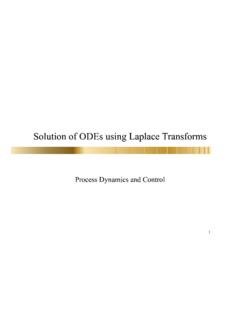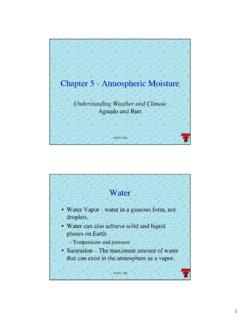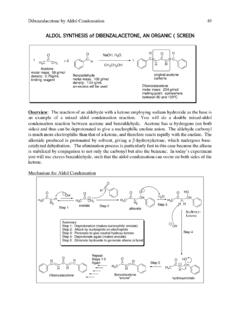Transcription of Chapter 18 Ethanol distillation: the fundamentals
1 Ethanol distillation : the fundamentals 269 Chapter 18 Ethanol distillation : the fundamentalsR. Katzen, Madson and Moon, JrKATZEN International, Inc., Cincinnati, Ohio, USAF undamentals of a distilling systemCertain fundamental principles are common toall distilling systems. Modern distillation systemsare multi-stage, continuous, countercurrent,vapor-liquid contacting systems that operatewithin the physical laws that state that differentmaterials boil at different in Figure 1 is a typical distillationtower that could be employed to separate anideal mixture. Such a system would contain thefollowing elements:a. a feed composed of the two components tobe separated,b. a source of energy to drive the process (inmost cases, this energy source is steam, eitherdirectly entering the base of the tower ortransferring its energy to the tower contentsthrough an indirect heat exchanger called areboiler),c. an overhead, purified product consistingprimarily of the feed component with thelower boiling point,d.
2 A bottoms product containing the componentof the feed possessing the higher boilingpoint,e. an overhead heat exchanger (condenser),normally water-cooled, to condense the vaporresulting from the boiling created by theenergy input. The overhead vapor, aftercondensation, is split into two streams. Onestream is the overhead product; the other isthe reflux which is returned to the top of thetower to supply the liquid downflow requiredin the upper portion of the portion of the tower above the feed entrypoint is defined as the rectifying section of thetower. The part of the tower below the feed entrypoint is referred to as the stripping section ofthe system shown in Figure 1 is typical forthe separation of a two component feedconsisting of ideal, or nearly ideal, componentsinto a relatively pure, overhead productcontaining the lower boiling component and abottoms product containing primarily the higherboiling component of the original energy was cheap and the Ethanol -watersystem was ideal, then this rather simpledistillation system would suffice for the sep-aration of the beer feed into a relatively pureethanol overhead product and a bottomsproduct of stillage, cleanly stripped of its ethanolcontent.
3 Unfortunately, the Ethanol -water (beer)mixture is not an ideal system. The balance of270 R. Katzen, Madson and Moon, Chapter will be devoted to a description ofthe modifications required of the simpledistillation system in order to make it effectivefor the separation of a very pure Ethanol product,essentially free of its water 2 expands on Figure 1 by showing someadditional features of a distillation tower. Theseare:a. The highest temperature in the tower willoccur at the The temperature in the tower will regularlyand progressively decrease from the bottomto the top of the The tower will have a number of similar,individual, internal components referred to as trays (these may also be described as stagesor contactors).d. Vapor will rise up the tower and liquid willflow down the tower. The purpose of thetower internals (trays) is to allow intimatecontact between rising vapors and descend-ing liquids correlated separation of vapor 3 shows a vapor-liquid equilibrium diagramfor the Ethanol -water system at atmosphericpressure.
4 The diagram shows mole percentethanol in the liquid (X axis) vs mole percentethanol in the vapor (Y axis). The plot couldalso be made for volume percent in the liquid vsvolume percent in the vapor and the equilibriumFigure 1. Ideal distillation distillation : the fundamentals 271curve would only be slightly displaced from thatshown in Figure 3. Mole percent is generally usedby engineers to analyze vapor/liquid separationsystems because it relates directly to molecularinteractions, which more closely describe theprocess occurring in a distillation of the Ethanol -water distillationsystem is mathematically straightforward whenusing molar quantities rather than the more com-mon measurements of volume or weight. Thisis because of an energy balance principle called constant molal overflow . Essentially, thisprinciple states that the heat (energy) requiredto vaporize or condense a mole of Ethanol isapproximately equal to the heat (energy)required to vaporize or condense a mole ofwater; and is approximately equal to the heat(energy) required to vaporize or condense anymixture of the two.
5 This relationship allows thetower to be analyzed by graphic techniques usingstraight lines. If constant molal overflow did notoccur, then the tower analysis would becomequite complex and would not lend itself easily tographic to Figure 3, a 45o line is drawn fromthe compositions of the 0, 0-100% and 100%.This 45o line is useful for determining ranges ofcompositions that can be separated by distill-ation. Since the 45o line represents the potentialpoints at which the concentration in the vaporequals the concentration in the liquid; it indicatesthose conditions under which distillation isFigure 2. Typical distillation R. Katzen, Madson and Moon, for performing the separation. If theequilibrium curve contacts the 45o line, aninfinitely large distillation tower would berequired to distill to that composition of vaporand liquid. Further, if the equilibrium curve crossesthe 45o line, the mixture has formed an azeo-trope.
6 This means that even if the tower wereinfinitely large with an infinite amount of energy,it would be impossible to distill past that point bysimple a very simple system consisting ofa pot filled with a mixture of Ethanol in water (abeer) containing 10 % by volume Ethanol ( %). This composition is identified in thelower left portion of Figure 3. A fire could bekindled under the pot, which would add thermalenergy to the system. The pot would begin toboil and generate some vapor. If we gathered asmall portion of the vapor initially generated andmeasured its Ethanol content; we would findabout 24 mole % Ethanol (53 volume %). If wecondense this vapor (note: there will be only asmall amount of this vapor), boil it in a secondpot and again collect a small amount of the firstvapor generated, this second vapor wouldcontain about 55 mole % (83 volume %) ofethanol (see Figure 3). If we should continuethis simplified process to a third and fourthFigure 3.
7 Vapor/liquid equilibrium for the Ethanol /water system at atmospheric distillation : the fundamentals 273collection of small amounts of vapor; analysiswould reveal that each successive portion ofvapor would become richer in we have created a series of steps bywhich we kept increasing the Ethanol contentof the analyzed sample, both liquid and , this oversimplified process isidealized; and practically speaking, is if we had supplied our original pot witha continuous supply of Ethanol -water feed andvapor generated in the first pot was continuouslycondensed and supplied to the second pot, the process becomes similar to the industrialdistillation tower operation shown in Figure far can this process be extended? Couldwe produce pure Ethanol by continuouslyextending our process of boiling and reboiling?The answer is, no! We would finally reach a pointin one of the downstream pots, where the vaporboiling off of the liquid was of the samecomposition as the liquid from which it was beinggenerated.
8 This unfortunate consequence limitsour ability to produce anydrous Ethanol from adilute Ethanol -water feed. What we finallyencounter in our simp-lified process is theformation of an azeotrope . This is a concen-trated solution of Ethanol and water that whenboiled produces a vapor with a compositionidentical to the composition of the liquid solutionfrom which it summary then, we are limited in Ethanol -water purification in any single multistage distill-ation tower to the production of azeotropicethanol-water mixtures. These azeotropicsolutions of Ethanol and water are also knownas constant boiling mixures (CBM) since theazeotropic liquid will have the same temperatureas the azeotropic equilibrium vapor being boiledfrom itself. Without some sort of drastic processintervention, further Ethanol purification be-comes impossible. The question then becomes:What can we do to make it possible to produceanhydrous Ethanol ?
9 Methods of doing so willbe covered later in this 4 depicts the structure of the distillationprocess by dividing the vapor/liquid equilibriuminformation into three distinct zones of processand equipment requirements: stripping, rectifyingand dehydration. This division is the basis for thedesign of equipment and systems to perform thedistillation in preliminary designThe engineer, given the assignment of designinga distillation tower, is faced with a number offundamental considerations. These include:a. What sort of contacting device should beemployed? ( trays or packing). If trays arechosen, what type will give the most intimatecontact of vapor and liquid?b. How much vapor is needed? How muchliquid reflux is required? (What ratio of liquid:vapor is required?)c. How much steam (energy) will be required?d. What are the general dimensions of thedistillation tower? distillation contactorsTrays are the most common contactor in are the functions expected of tray contac-tors in the tower?
10 Figure 5 depicts a single traycontactor in a distillation tower and shows theprimary functions desired:- Mixing rising vapor with a falling Allow for separation after Provide path for liquid to proceed down Provide path for liquid to proceed up 6 depicts a perforated tray contactor withcertain accoutrements required to control theflow of liquid and vapor and to assure theirintimate contact. Another type of tray contactingdevice, the disc-and-donut or baffle tray is shownin Figure 7. The characteristics of this type ofcontactor make it especially useful for distillingmaterials such as dry-milled grain beer, whichwould foul ordinary R. Katzen, Madson and Moon, analysisIn addition to the selection of the basic contactingdevice, the energy requirement must be estab-lished. This is accomplished by analyzing thevapor/liquid equilibrium data from Figure 4, forthe liquid:vapor ratio to perform a continuousseries of steps within the limits of the equilibriumcurve.








